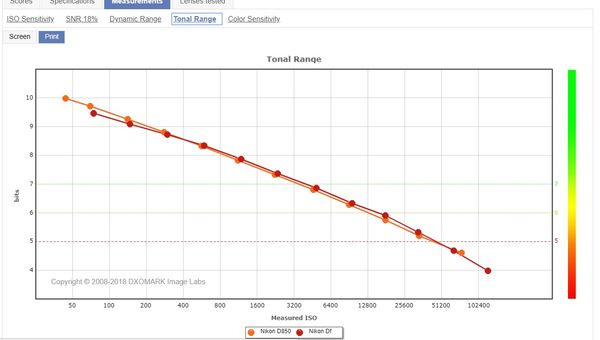Question for high MP (36mp and up) camera users
Mar 31, 2019 18:16:14 #
larryepage
Loc: North Texas area
Rich1939 wrote:
This question is purely to satisfy my curiosity.
The larger pixel count cameras are universally praised for their ability to capture fine detail because of that pixel count. Does that high count also contribute to better tone graduations?
The larger pixel count cameras are universally praised for their ability to capture fine detail because of that pixel count. Does that high count also contribute to better tone graduations?
There is no physical reason that higher pixel counts lead directly to better tone gradation. But...higher pixel count (really density) does allow better definition from one detail area to another. That could create a perception of "better."
What is real, though, is that higher pixel count cameras are newer. The technology for the sensor is generally newer and improved over previous models. And it's likely that the processor is a newer generation. And there may be more and better controls for setup.
So there are lots of reasons you should expect the image to look better.
Mar 31, 2019 18:35:05 #
larryepage wrote:
There is no physical reason that higher pixel coun... (show quote)
A higher pixel count simply put means less of a jump from one to the other. I am questioning if higher pixel density can give us smoother gradations. New or old technology isn't relevant to that question. BTW color is a detail.
Mar 31, 2019 18:38:55 #
selmslie wrote:
You can just about see some of the steps in an 8-b... (show quote)
Those steps are per pixel. The question remains if there are more pixels per in, sensor versus sensor, will the one with a higher density have the potential to give us smoother tones all things being equal other than density?
Mar 31, 2019 20:49:45 #
Rich1939 wrote:
Those steps are per pixel. The question remains if there are more pixels per in, sensor versus sensor, will the one with a higher density have the potential to give us smoother tones all things being equal other than density?
More pixels just mean that you can make a larger print before you can see pixelation.
For an 8-bit image (256 steps from blackj to white) you just might barely be able to detect the jump from a brightness value of 127 to 128. But for a 16-bit image that takes 256 distinct steps from 127x256 to 128x256. That is where the smooth tonality is comes from.
Mar 31, 2019 23:00:51 #
Rich1939 wrote:
Am I wrong in that? I am trying to learn something here.
Rich I am sorry my earlier explanation did not make sense. I will try again to explain why the #pixels does not connect to tonality.
See the two images below. They both have the same number of pixels. Both range from Black on the left side to white on the right side.
The first has only two tones. Black and white. Pixels can only be black or white. Not much tonality right?
The 2nd one has a gradual variation of the pixel shades from black to white. That is tonality. It is the number of shades that each pixels can take that matters. Higher pixel count => smaller pixels does not translate to more shades of grey per pixel.
I hope that makes more sense.
Apr 1, 2019 06:26:51 #
Higher pixel counts don't produce a wide tonal range. I loaded the Nikon Df (16 megapixel) and the Nikon D850 (45 megapixel) cameras into the DxO Labs sensor comparison tool. You can see the two camera's tonal range are practically identical.
Apr 1, 2019 06:28:09 #
Rich1939 wrote:
This question is purely to satisfy my curiosity.
The larger pixel count cameras are universally praised for their ability to capture fine detail because of that pixel count. Does that high count also contribute to better tone graduations?
The larger pixel count cameras are universally praised for their ability to capture fine detail because of that pixel count. Does that high count also contribute to better tone graduations?
No. What contributes to better tonal gradation is shooting raw and processing in 16 bit. Jpgs are 8 bits, which means 256 steps between total black and total white. Actually most raw is 12 or 14 bits. 12 bits is already 4096 steps.
Apr 1, 2019 06:50:16 #
I have a Nikon D750, D800 and D810. I trust Nikon engineers to get it right. But you have multiple elements in each of these cameras impacting tone graduations.
The larger the pixel the more accurate photoelectric light reponse. So pixel to pixel changes are likely more accurate. The higher pixel density sensors, where it's apparent that high contrast changes create sharper edges, I assume the graduation are smoother. I haven't seen the Nikon engineers sacrifice image quality going to higher pixel counts. Some photographers may have the opinion the sharper images of modern cameras aren't as aesthetically pleasing, that is an issue that belongs in post processing. It is not unusual for me to lower contrast in my images.
Then the antialias filter on my D800 appears to soften graduations as compared to the D810.
Plus you have to consider whether a particular lens delivers light to the sensor accurately on the scale of pixel density. Without a doubt I have lenses I use that negate the D800 and D810's higher pixel density. The first example is my 70-300mm VR. I think the sharpness is maxed out before we get to the D750's 24 MP.
The larger the pixel the more accurate photoelectric light reponse. So pixel to pixel changes are likely more accurate. The higher pixel density sensors, where it's apparent that high contrast changes create sharper edges, I assume the graduation are smoother. I haven't seen the Nikon engineers sacrifice image quality going to higher pixel counts. Some photographers may have the opinion the sharper images of modern cameras aren't as aesthetically pleasing, that is an issue that belongs in post processing. It is not unusual for me to lower contrast in my images.
Then the antialias filter on my D800 appears to soften graduations as compared to the D810.
Plus you have to consider whether a particular lens delivers light to the sensor accurately on the scale of pixel density. Without a doubt I have lenses I use that negate the D800 and D810's higher pixel density. The first example is my 70-300mm VR. I think the sharpness is maxed out before we get to the D750's 24 MP.
Apr 1, 2019 07:11:38 #
boydcrochet wrote:
... Plus you have to consider whether a particular lens delivers light to the sensor accurately on the scale of pixel density. Without a doubt I have lenses I use that negate the D800 and D810's higher pixel density. The first example is my 70-300mm VR. I think the sharpness is maxed out before we get to the D750's 24 MP.
Unfortunately, that is the case for most of our lenses.
All but the best (and some of the most expensive) prime lenses limit the system resolution. See Photographic System Resolution.
What we see with higher resolution sensors is the ability to make larger images. Post processing can add clarity apparent sharpness to make us believe that the end result looks sharper. Subjective impressions can trump mathematical evidence.
Apr 1, 2019 07:42:11 #
Rich1939 wrote:
This question is purely to satisfy my curiosity.
The larger pixel count cameras are universally praised for their ability to capture fine detail because of that pixel count. Does that high count also contribute to better tone graduations?
The larger pixel count cameras are universally praised for their ability to capture fine detail because of that pixel count. Does that high count also contribute to better tone graduations?
I shoot a 5DSR and really can't answer your question but I will give you something to think about. The pixel density of a 36mp full frame is not as dense as an 18mp crop camera.
Apr 1, 2019 07:46:33 #
If the pixels are invisible to the eye then so are the tonal gradations. Each photosite has thousands of possible tonal values. Gradations depend on how those values change across a span of photosites.
Film is much more like a halftone screen, it has no intermediate tones, just black grains and transparent areas where there are no grains. The closer the grains are together the darker the appearance of that area. So of course larger format film will appear to have finer tonal gradations because there are more possible variations in grain density across a given area. .
But photosites have thousands of possible values, not just two. It is a whole different ballgame.
Color film is basically the same, just multiply by three color dyes: colored or clear instead of black or clear.
Film is much more like a halftone screen, it has no intermediate tones, just black grains and transparent areas where there are no grains. The closer the grains are together the darker the appearance of that area. So of course larger format film will appear to have finer tonal gradations because there are more possible variations in grain density across a given area. .
But photosites have thousands of possible values, not just two. It is a whole different ballgame.
Color film is basically the same, just multiply by three color dyes: colored or clear instead of black or clear.
Apr 1, 2019 08:01:58 #
I may have been using the wrong word, lo these many years. Is it not gradations and not graduations? I was no Enlish teacher, but strive to not use what my English Teachers referred to as “malaprops.” I am interested to read other opinions or conclusions on this issue of paramount importance.
Apr 1, 2019 08:31:25 #
CWGordon wrote:
I may have been using the wrong word, lo these many years. Is it not gradations and not graduations? I was no Enlish teacher, but strive to not use what my English Teachers referred to as “malaprops.” I am interested to read other opinions or conclusions on this issue of paramount importance.
<larrypage> and <kymorto> have already corrected the mistake: as all academics like myself know, graduation is strictly used for students reaching their final goal; the proper word for gradual change is gradation.
Apr 1, 2019 08:46:35 #
kymarto wrote:
If the pixels are invisible to the eye then so are... (show quote)
Thank you for this!
"Film is much more like a halftone screen, it has no intermediate tones, just black grains and transparent areas where there are no grains."
That grains in film are two state,either off or on, was escaping me.
Wouldn't more pixels per area, each with thousands of possible values, also be able to appear to have finer gradations then vs. less?
Apr 1, 2019 09:59:42 #
gvarner
Loc: Central Oregon Coast
Viewed on a screen you probably wouldn’t see any difference at normal reproduction ratios. Make a very large print and view it at a normal viewing distance and you may see a difference.
If you want to reply, then register here. Registration is free and your account is created instantly, so you can post right away.









